Stash vs E*TRADE (2024)
Stash vs. E*TRADE: Which Broker is Best?
Stash and E*TRADE are both popular brokers with plenty of great features. They each have a different approach to investing and appeal to different types of investors.
One is a simple, app-based fin-tech broker focused on auto-investing. The other is a full-featured broker offering a complete range of services and investment opportunities. The ‘better’ one is the one that suits your individual needs and expectations.
Let’s see if Stash or E*TRADE is the best broker in 2024.
Broker Cost
| Broker Fees |
Stock/ETF
Commission |
Mutual Fund
Commission |
Options
Commission |
Maintenance
Fee |
Annual IRA
Fee |
|
Etrade
|
$0
|
$0
|
$0 + $0.65 per contract
|
$0
|
$0
|
|
Stash
|
$0
|
na
|
na
|
$3 or $9 per month
|
$3 or $9 per month
|
Services
Broker services are an important deciding factor when comparing brokers. You’ll find a broader range of services at E*TRADE, but Stash is no slouch (for what it is). Here’s how they compare.

Investment vehicles at Stash include U.S.-listed stocks (limited selection), ETFs, and Crypto (limited selection). At E*TRADE, you have access to all the U.S.-listed stocks, ETFs, and indices. You can also access OTC, ADRs, penny stocks, options, futures, IPOs, Bonds, CDs, and mutual funds.
Account types available at Stash include standard brokerage accounts, a custodial account option (with a top-tier subscription), and a retirement account option (Roth or Traditional). E*TRADE offers many different types of retirement accounts, managed portfolios, small business brokerage accounts, and a bank account (from Morgan Stanley).
Cash management features at Stash are convenient but slim compared to a traditional bank account. You can park money in your ‘bank account’ on Stash and spend your money with the provided debit card. At E*TRADE, you get an actual checking/savings account with all the expected features.
Educational material available at Stash covers the basics well. You’ll find a blog with updated topics and dedicated mini-lessons focused on products available at the broker. E*TRADE’s educational content is similar in scope but covers more advanced investing and money management concepts.

When it comes to who offers the most in terms of broker services, E*TRADE comes out on top.
| Broker Review |
Cost |
Investment Products |
Trading Tools |
Customer Service |
Research |
Overall Rating |
|
Etrade
|

|

|

|

|

|

|
|
Stash
|

|

|

|

|

|

|
Promotions
E*TRADE:
At E*TRADE, get $0 trades + 65₵ per options contract.
Stash:
$20 in free stock when you open a new account.
Tools, Apps, and Platforms
Regarding tools, apps, and platforms, E*TRADE provides investors with more in almost every category.
Stash’s most notable tools are automated investing, automated deposits, DRIP, thematic investing, and a user-friendly mobile application.

E*TRADE has all the same features except for automated deposits. In addition, E*TRADE also offers tools like screeners, custom calculators, live news feeds, and more. E*TRADE’s two mobile apps come with all the bells and whistles you expect from a top broker.

For trading platforms, there is no contest. E*TRADE has two trading platforms (a web-based platform and a downloadable desktop solution). Stash does not have one.
Promotions and Deals
If promotions and deals are important to you, E*TRADE is slightly better than Stash. Not only does E*TRADE offer a better variety of bonuses, but they also have offers catering to active investors.
Stash’s main promotion is the Give and Get $20 referral program. When you invite a new customer to sign up at the broker, you and your referee get $20. You can continue referring new customers as long as you want, but once you reach a total of $500 in bonus funds in a single year, you’ll need to wait until the following to start the process again.

Apart from the referral program, Stash also has a ‘Stock-Back’ program attached to the broker’s debit card. When you use the card to shop and spend money, Stash gives you rewards in the form of fractional shares. Depending on your situation, this could be a valuable feature.
At E*TRADE, you’ll find a similar referral program. For each referral you make, you and your referee receive a $50 Amazon gift card. E*TRADE’s referral bonus is also set to a $500 per year limit, but it is faster to reach that limit since the reward is so much higher. The only catch is that you have to spend the money at Amazon instead of reinvesting it.

E*TRADE also has a deposit bonus for new customers. Simply by depositing funds into your new brokerage account, you can get as much as $600 in bonus cash.

Finally, E*TRADE rewards active traders by reducing commissions on options and OTC shares. The reduction is triggered by making at least 30 trades in a quarter.
Ease of Use
Of the two brokers, Stash is definitely the easier one to use.
Stash was built with convenience in mind and does an excellent job of giving investors access to various tools and services right from the mobile application. Whether you are trying to research an idea, build a new portfolio, or manage an existing one, Stash makes it easy to interact with the financial markets.

E*TRADE is also relatively easy to use. However, as a full-fledged broker with various trading platforms, the ease at which an investor can utilize the broker’s services depends on what they are trying to achieve. You’ll get a similarly simple experience using E*TRADE’s mobile apps, but the website and trading platforms are more complex.

It is helpful to remember that ‘easy’ is not always the better choice when managing your wealth. However, if you are after simplicity, Stash is a clear winner.
Cost and Fees
Stash does not have minimum balance requirements to start or maintain an account. That doesn't mean operating a Stash account is free, however.
Stash has two subscription levels, each with its own monthly fee. The basic option (Stash Growth) comes in at $3 per month, and the advanced subscription (Stash+) is set at $9 per month.

Brokerage subscription fees may not be everyone's cup of tea, but numerous services and benefits come with the subscriptions that might make them worthwhile.
E*TRADE is the cheaper broker once you have met the account thresholds to unlock advanced services. E*TRADE does not charge commissions on (most) trades, nor does it enforce any minimum balance or maintenance fee requirement.

However, you will need at least $1,000 in your trading account to access some of the broker's better features. The 1K threshold can be bypassed by making 30+ trades in a quarter.
In terms of cost, E*TRADE comes out on top.
Competitors
Pros and Cons
E*TRADE and Stash are both good brokers, but there are some notable strengths and weaknesses.
STASH Pros
- Lots of great features packed into a user-friendly app
- Cryptocurrency access through Apex Crypto
- Several account types to choose from
- Tiered pricing structure allows investors to choose their level of commitment
- Auto-invest features are convenient
- Stock-Back card helps investors save money
STASH Cons
- No active trading
- Monthly subscription is unappealing to some
- Limited cryptocurrency availability
- No trading platform
E*TRADE Pros
- Long list of securities, including OTC, ADRs, futures, stocks, bonds, CDs, and more.
- Good selection of account types available
- Multiple trading platforms
- Two mobile applications
- Multiple promotions
- Competitive pricing schedule
E*TRADE Cons
- ‘Free’ features need to be unlocked by meeting monetary requirements
- No direct cryptocurrency access
- No third-party indicator support on trading platforms
Promotions
E*TRADE:
At E*TRADE, get $0 trades + 65₵ per options contract.
Stash:
$20 in free stock when you open a new account.
Stash vs E*TRADE Recommendations
Both Stash and E*TRADE are good brokers with a lot to offer. However, the two seem to have very different views on how investing should be carried out.
Investors looking for a ‘no-brainer’ solution to investing will likely do better with Stash. The broker has cash management, several account types, and auto-invest features that take the work out of portfolio management (and investing in general).
Anyone looking for a more traditional broker will undoubtedly appreciate what E*TRADE offers. The long list of investible securities, access to multiple trading platforms, auto-investing, cash management, and an attractive rewards program all come together to create a ‘complete package.’
In summary, nearly everything Stash offers is available at E*TRADE, although E*TRADE has many tools and services that Stash does not provide.
If a higher degree of control over your investment activity is what you want, E*TRADE is the obvious winner.
If simplicity is what you want, Stash is the better option.